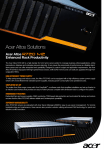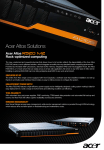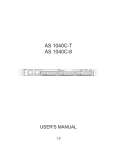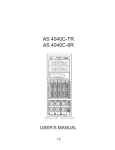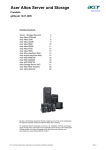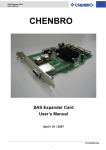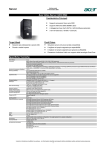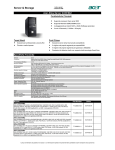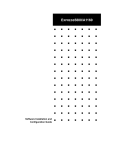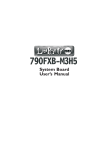Download Acer G5450 User's Manual
Transcript
Acer Altos G5450 Series User’s Guide Copyright © 2007 Acer Incorporated All Rights Reserved. Acer Altos G5450 Series User’s Guide Changes may be made periodically to the information in this publication without obligation to notify any person of such revision or changes. Such changes will be incorporated in new editions of this manual or supplementary documents and publications. This company makes no representations or warranties, either expressed or implied, with respect to the contents hereof and specifically disclaims the implied warranties of merchantability or fitness for a particular purpose. Record the model number, serial number, purchase date, and place of purchase information in the space provided below. The serial number and model number are recorded on the label affixed to the unit. All correspondence concerning the unit should include these information. No part of this publication may be reproduced, stored in a retrieval system, or transmitted, in any form or by any means, electronic, mechanical, photocopy, recording, or otherwise, without the prior written permission of Acer Incorporated. Acer Altos G5450 Series Model Name : G5450 Part Number: MU.R2700.001 Purchase Date: Place of Purchase: Acer and the Acer logo are registered trademarks of Acer Inc. Other company’s product names or trademarks are used herein for identification purposes only and belong to their respective companies. iii Notices FCC declaration of conformity This device complies with Part 15 of the FCC Rules. Operation is subject to the following two conditions: (1) this device may not cause harmful interference, and (2) this device must accept any interference received, including interference that may cause undesired operation. The following local manufacturer/importer is responsible for this declaration: Product: Server Model number: G5450 Name of responsible party: Acer America Corporation Address of responsible party: 2641 Orchard Parkway, San Jose CA 95134, U. S. A. Contact person: Mr. Young Kim Phone number: 408-922-2909 Fax number: 408-922-2606 FCC notice Class A devices do not have an FCC logo or FCC IDE on the label. Class B devices have an FCC logo or FCC IDE on the label. Once the class of the device is determined, refer to the following corresponding statement. Class A equipment This device has been tested and found to comply with the limits for a Class A digital device pursuant to Part 15 of the FCC Rules. These limits are designed to provide reasonable protection against harmful interference when the equipment is operated in a commercial environment. This equipment generates, uses, and can radiate radio frequency energy, and if not installed and used in accordance with the instructions, may cause harmful interference to radio communications. Operation of this equipment in a residential area is likely to cause harmful interference, in which case the user will be required to correct the interference at personal expense. Notice: Shielded cables All connections to other computing devices must be made using shielded cables to maintain compliance with FCC regulations. iv Notice: Peripheral devices Only peripherals (input/output devices, terminals, printers, etc.) certified to comply with the Class A limits may be attached to this equipment. Operation with noncertified peripherals is likely to result in interference to radio and TV reception. Caution: Changes or modifications not expressly approved by the manufacturer could void the user’s authority, which is granted by the Federal Communications Commission, to operate this server. Use conditions This part complies with Part 15 of the FCC Rules. Operation is subject to the following two conditions: (1) this device may not cause harmful interference, and (2) this device must accept any interference received, including interference that may cause undesired operation. Notice: Canadian users This Class A digital apparatus meets all requirements of the Canadian Interference-Causing Equipment Regulations. Remarque à l'intention des utilisateurs canadiens Cet appareil numérique de la classe A est conforme a la norme NMB-003 du Canada. Laser compliance statement The CD or DVD drive used with this computer is a laser product. The CD or DVD drive's classification label (shown below) is located on the drive. CLASS 1 LASER PRODUCT CAUTION: INVISIBLE LASER RADIATION WHEN OPEN. AVOID EXPOSURE TO BEAM. APPAREIL A LASER DE CLASSE 1 PRODUIT LASERATTENTION: RADIATION DU FAISCEAU LASER INVISIBLE EN CAS D'OUVERTURE. EVITTER TOUTE EXPOSITION AUX RAYONS. LUOKAN 1 LASERLAITE LASER KLASSE 1 VORSICHT: UNSICHTBARE LASERSTRAHLUNG, WENN ABDECKUNG GEÖFFNET NICHT DEM STRAHLL AUSSETZEN. PRODUCTO LÁSER DE LA CLASE I ADVERTENCIA: RADIACIÓN LÁSER INVISIBLE AL SER ABIERTO. EVITE EXPONERSE A LOS RAYOS. v ADVARSEL: LASERSTRÅLING VEDÅBNING SE IKKE IND I STRÅLEN. VARO: LAVATTAESSA OLET ALTTINA LASERSÅTEILYLLE. VARNING: LASERSTRÅLNING NÅR DENNA DEL ÅR ÖPPNAD ÅLÅ TUIJOTA SÅTEESEENSTIRRA EJ IN I STRÅLEN. VARNING: LASERSTRÅLNING NAR DENNA DEL ÅR ÖPPNADSTIRRA EJ IN I STRÅLEN. ADVARSEL: LASERSTRÅLING NAR DEKSEL ÅPNESSTIRR IKKE INN I STRÅLEN. Macrovision copyright protection notice "U.S Patent Nos. 4,631,603; 4,819,098; 4,907,093; 5,315,448; and 6,516,132." This product incorporates copyright protection technology that is protected by U.S. patents and other intellectual property rights. Use of this copyright protection technology must be authorized by Macrovision, and is intended for home and other limited viewing uses only unless otherwise authorized by Macrovision. Reverse engineering or disassembly is prohibited. vi CE Declaration of conformity We, Acer Computer (Shanghai) Limited 3F, No. 168 Xizang Medium Road, Huangpu District, Shanghai, China Contact Person: Mr. Easy Lai Tel: 886-2-8691-3089 Fax: 886-2-8691-3000 E-mail: [email protected] Hereby declare that: Product: Server Trade name: Acer Model number: G5450 SKU number: G54xx ("x" = 0~9, a~z, A~Z or blank) Is compliant with the essential requirements and other relevant provisions of the following EC directives, and that all the necessary steps have been taken and are in force to assure that production units of the same product will continue to comply with these requirements. • • EMC Directive 89/336/EEC, amended by 92/31/EEC and 93/68/EEC as attested by conformity with the following harmonized standards: • EN55022:1998 + A1:2000 + A2:2003, AS/NZS CISPR22:2002, Class B • EN55024:1998 + A1:2001 + A2:2003 • EN61000-3-2:2000, Class D • EN61000-3-3:1995 + A1:2001 Low Voltage Directive 73/23/EEC as attested by conformity with the following harmonized standard: • • EN60950-1:2001 RoHS Directive 2002/95/EC on the Restriction of the Use of certain Hazardous Substances in Electrical and Electronic Equipment Director, Acer Computer (Shanghai) Limited November 20, 2007 vii Declaration of conformity for EU countries Hereby, Acer, declares that this PC series is in compliance with the essential requirements and other relevant provisions of Directive 1999/5/EC. Russian regulatory certification compliance viii Information for your safety and comfort Safety instructions Read these instructions carefully. Keep this document for future reference. Follow all warnings and instructions marked on the product. Turning the product off before cleaning Unplug this product from the wall outlet before cleaning. Do not use liquid cleaners or aerosol cleaners. Use a damp cloth for cleaning. CAUTION for plug as disconnecting device Observe the following guidelines when connecting and disconnecting power to the power supply unit: • Install the power supply unit before connecting the power cord to the AC power outlet. • Unplug the power cord before removing the power supply unit from the server. • If the system has multiple sources of power, disconnect power from the system by unplugging all power cords from the power supplies. CAUTION for accessibility Be sure that the power outlet you plug the power cord into is easily accessible and located as close to the equipment operator as possible. When you need to disconnect power to the equipment, be sure to unplug the power cord from the electrical outlet. Usage warnings • Do not use this product near water. Never spill liquid of any kind onto or into the product. • Do not place this product on an unstable cart, stand or table. If the product falls, it could be seriously damaged. ix • Slots and openings are provided for ventilation to ensure reliable operation of the product and to protect it from overheating. These openings must not be blocked or covered. The openings should never be blocked by placing the product on a bed, sofa, rug or other similar surface. This product should never be placed near or over a radiator or heat register, or in a built-in installation unless proper ventilation is provided. • Never push objects of any kind into this product through cabinet slots as they may touch dangerous voltage points or short-out parts that could result in a fire or electric shock. • To avoid damage of internal components and to prevent battery leakage, do not place the product on a vibrating surface. • Never use it under sporting, exercising, or any vibrating environment which will probably cause unexpected short current or damage rotor devices, hard drives, optical drives, and even exposure risk from lithium battery pack. Using electrical power • This product should be operated from the type of power indicated on the marking label. If you are not sure of the type of power available, consult your dealer or local power company. • Do not allow anything to rest on the power cord. Do not locate this product where people will walk on the cord. • If an extension cord is used with this product, make sure that the total ampere rating of the equipment plugged into the extension cord does not exceed the extension cord ampere rating. Also, make sure that the total rating of all products plugged into the wall outlet does not exceed the fuse rating. • Do not overload a power outlet, strip or receptacle by plugging in too many devices. The overall system load must not exceed 80% of the branch circuit rating. If power strips are used, the load should not exceed 80% of the power strip's input rating. • This product's power supply is equipped with a three-wire grounded plug. The plug only fits in a grounded power outlet. Make sure the power outlet is properly grounded before inserting the power supply plug. Do not insert the plug into a non-grounded power outlet. Contact your electrician for details. x Warning! The grounding pin is a safety feature. Using a power outlet that is not properly grounded may result in electric shock and/or injury. Note: The grounding pin also provides good protection from unexpected noise produced by other nearby electrical devices that may interfere with the performance of this product. • Use the product only with the supplied power supply cord set. If you need to replace the power cord set, make sure that the new power cord meets the following requirements: detachable type, UL listed/CSA certified, type SPT-2, rated 7 A 125 V minimum, VDE approved or its equivalent, 4.6 meters (15 feet) maximum length. Safe listening Follow these instructions, suggested by hearing experts,to protect your hearing. • Gradually increase the volume until you can hear it clearly and comfortably and without distortion. • After setting the volume level, do not increase it after your ears adjust. • Limit the amount of time listening to music at high volume. • Avoid turning up the volume to block out noisy surroundings. • Turn the volume down if you can't hear people speaking near you. Product servicing Do not attempt to service this product yourself, as opening or removing covers may expose you to dangerous voltage points or other risks. Refer all servicing to qualified service personnel. Unplug this product from the wall outlet and refer servicing to qualified service personnel when: • the power cord or plug is damaged, cut or frayed • liquid was spilled into the product • the product was exposed to rain or water • the product has been dropped or the case has been damaged xi • the product exhibits a distinct change in performance, indicating a need for service • the product does not operate normally after following the operating instructions Note: Adjust only those controls that are covered by the operating instructions, since improper adjustment of other controls may result in damage and will often require extensive work by a qualified technician to restore the product to normal condition. Disposal instructions Do not throw this electronic device into the trash when discarding. To minimize pollution and ensure utmost protection of the global environment, please recycle. For more information on the Waste from Electrical and Electronics Equipment (WEEE) regulations, visit http://global.acer.com/about/ sustainability.htm. Mercury advisory For projectors or electronic products containing an LCD/CRT monitor or display: Lamp(s) inside this product contain mercury and must be recycled or disposed of according to local, state or federal laws. For more information, contact the Electronic Industries Alliance at http://www.eiae.org. For lamp-specific disposal information, check http://www.lamprecycle.org. xii Tips and information for comfortable use Computer users may complain of eyestrain and headaches after prolonged use. Users are also at risk of physical injury after long hours of working in front of a computer. Long work periods, bad posture, poor work habits, stress, inadequate working conditions, personal health and other factors greatly increase the risk of physical injury. Incorrect computer usage may lead to carpal tunnel syndrome, tendonitis, tenosynovitis or other musculoskeletal disorders. The following symptoms may appear in the hands, wrists, arms, shoulders, neck or back: • numbness, or a burning or tingling sensation • aching, soreness or tenderness • pain, swelling or throbbing • stiffness or tightness • coldness or weakness If you have these symptoms, or any other recurring or persistent discomfort and/or pain related to computer use, consult a physician immediately and inform your company's health and safety department. The following sections provide tips for more comfortable computer use. Finding your comfort zone Find your comfort zone by adjusting the viewing angle of the monitor, using a footrest, or raising your sitting height to achieve maximum comfort. Observe the following tips: • Refrain from staying too long in one fixed posture. • Avoid slouching forward and/or leaning backward. • Stand up and walk around regularly to remove the strain on your leg muscles. • Take short rests to relax your neck and shoulders. • Avoid tensing your muscles or shrugging your shoulders. • Install the external display, keyboard and mouse properly and within comfortable reach. • If you view your monitor more than your documents, place the display at the center of your desk to minimize neck strain. xiii Taking care of your vision Long viewing hours, wearing incorrect glasses or contact lenses, glare, excessive room lighting, poorly focused screens, very small typefaces and low-contrast displays could stress your eyes. The following items provide suggestions on how to reduce eyestrain. • • Eyes • Rest your eyes frequently. • Give your eyes regular breaks by looking away from the monitor and focusing on a distant point. • Blink frequently to keep your eyes from drying out. Display • Keep your display clean. • Keep your head at a higher level than the top edge of the display so your eyes point downward when looking at the middle of the display. • Adjust the display brightness and/or contrast to a comfortable level for enhanced text readability and graphics clarity. • Eliminate glare and reflections by: – placing your display in such a way that the side faces the window or any light source – minimizing room light by using drapes, shades or blinds – using a task light – changing the display's viewing angle – using a glare-reduction filter – using a display visor, such as a piece of cardboard extended from the display's top front edge • Avoid adjusting your display to an awkward viewing angle. • Avoid looking at bright light sources, such as open windows, for extended periods of time. xiv Developing good work habits Develop the following work habits to make your computer use more relaxing and productive: • Take short breaks regularly and often. • Perform some stretching exercises. • Breathe fresh air as often as possible. • Exercise regularly and maintain a healthy body. Warning! We do not recommend using the computer on a couch or bed. If this is unavoidable, work for only short periods, take breaks regularly, and do some stretching exercises. System specifications Performance Mechanical Environmental Hardware options External and internal structure Front bezel Front panel Rear panel Internal components System boards Mainboard Backplane board BMC module ARMC/3 module System LED indicators Front panel LED indicators Hot-plug HDD LED indicator LAN port LED indicators Power supply module LED indicators 2 System setup Setting up the system Pre-installation requirements Connecting peripherals Turning on the system Power-on problems Configuring the system OS Rack mount configuration Turning off the system 3 System upgrade Installation precautions ESD precautions Pre-installation instructions Post-installation instructions Opening the server Removing the side panel Removing the front bezel Configuring the hard drive Installing a HDD cage 1 3 3 6 6 7 8 8 9 11 13 14 14 17 18 19 20 20 21 21 22 23 25 25 26 27 28 29 30 31 33 35 35 36 36 37 37 38 39 39 Contents 1 System tour xvi Removing a HDD cage Installing an additional hard drive Configuring a 5-25 inch storage device Upgrading the processor Upgrading the system memory DIMM population guidelines Removing a DIMM Installing a DIMM Installing an expansion card Installing the BMC module Installing the ARMC/3 module Installing a redundant power supply module 4 System BIOS BIOS overview Entering BIOS setup BIOS setup primary menus BIOS setup navigation keys Main menu Advanced menu Advanced Processor Options Memory Configuration Advanced Chipset Control PCI Configuration I/O Device Configuration IDE Configuration Floppy Configuration Boot Configuration DMI Event Logging Security menu Setting a system password Changing a system password Removing a system password Server menu System Management Console Redirection Event Log Configuration Boot menu Exit menu 5 System troubleshooting Resetting the system 42 43 46 48 52 53 56 57 58 60 61 65 67 70 71 71 72 73 74 74 76 77 78 79 80 82 83 84 86 87 88 88 89 90 90 92 93 94 95 97 xvii Initial system startup problems Initial troubleshooting checklist Hardware diagnostic testing Checking the boot-up status Verifying the condition of the storage devices Confirming loading of the operating system Specific problems and corrective actions Appendix A: Server management tools Server management overview RAID configuration utilities Configuring Onboard SATA RAID Configuring LSI MegaRAID SAS 8708ELP Configuring LSI MegaRAID SAS 8204ELP Appendix B: Rack mount configuration Rack installation information Rack installation precautions Rack mount kit Vertical mounting hole pattern Rack installation procedures Preparing the server for rack installation Preparing the rack for server installation Installing the server in the system rack Installing the cable arm option Index 129 98 99 100 100 101 101 102 107 109 110 110 111 112 115 117 117 118 120 121 121 123 125 126 xviii 1 System tour The Acer Altos G5450 server is a fully modular dual-processor system featuring the latest in computing technology. It hosts a range of powerful and flexible features designed to meet the needs of various network environments. From simple networking functions to computing intensive applications, the Altos G5450 delivers. 3 System specifications This section lists down the impressive computing features of the Altos G5450 system. Performance Processor • Two socket F (1207-pin) AMD processor sockets supporting DualCore / Quad-Core AMD Opteron™ processor • Up to 2x 1 MB L2 cache for dual-core processor • Up to 4x 512 KB L2 cache and 2MB L3 cache for quad-core processor 1 • Support for the following AMD technologies:2 • HyperTransport™ technology • AMD64 technology • AMD virtualization™ technology (AMD-V) • AMD PowerNow!™ technology • Enhanced virus pretection Chipset • NVIDIA nForce Professional 3600 media and communication processors (MCPs) Memory • Supports DDR2-667 registered ECC modules • Eight DIMM slots per processor • Single-processor supports memory capacity of 32 GB3 • Dual-processor supports memory capacity of 64 GB3 • Supports dual-channel DDR2 memory per processor • Support Memory Sparing technology 1 2 3 support depends on quad-core CPU available For more information on these AMD technologies, visit the AMD Opteron™ web site at http://www.amd.com/. support depends on 4 GB DIMM available 4 1 System tour PCI interface • Five PCI bus slots • Two PCI Express x16 bus slots with, one x16 throughput and one x8 throughput • One PCI Express x8 bus slot with x4 throughput • Two 32-bit/33 MHz PCI bus slot Video controller • Integrated XGI Z9s chipset with 16 MB DDR SDRAM • Optional add-on graphic card support SATA Controller • Integrated six-ports SATA2 controller onboard • Integrated SATA S/W RAID 0, 1, 5 & 10 Networking • Two Gigabit Ethernet LAN ports (RJ-45) • TCP Offload Engine (TOE) support Baseboard Management Controller (optional) • Baseboard Management Controller (BMC) module (optional) • Intelligent Platform Management Interface (IPMI) 2.0 compliant Media storage • • Three 5.25-inch device bays support: • DVD-ROM, DVD-RW drive • DAT tape drive • AIT tape drive • LTO half-height tape drive • 3.5” floppy disk drive (FDD) with FDD conversion kit Two hard disk drive (HDD) cage bays support: • Hot-swap or easy-swap HDD cages • Up to eight SAS/SATA2 drive support (four drives per HDD cage) 5 I/O ports • Two front USB 2.0 ports • Two rear USB 2.0 ports • PS/2 keyboard port • • PS/2 mouse port Two Gigabit LAN ports (RJ-45) • Serial port • Monitor port Power supply and system fan • 610-watts power supply with hot-swap redundant option • System fan with redundant or hot-swap redundant option Hardware monitoring and server management • Winbond W83792G hardware monitoring IC for voltage, temperature, and fan speed detection • LED indicators for constant monitoring of basic system function • Acer Server Management (ASM) monitors potential problem spots in the network environment Server Management Utilities and Applications • Acer EasyBuild™ • Acer Server Management (ASM) 7.1 • Acer eBusiness Value Pack (optional) • Acer eBusiness ValueSTOR (optional) Operating system • Microsoft® Windows® Server 2003 • Microsoft® Windows® Server 2003 x64 Editions • Red Hat® Enterprise Linux® 4.0 • Red Hat® Enterprise Linux® 4.0, x86-64 • SUSE Linux® Enterprise Server 10.0 • SUSE Linux® Enterprise Server 10.0, x86-64 6 1 System tour Mechanical • Chassis • Tool-less chassis design for easy hardware access and configuration • Tower and rack-mount (5U, tray-less) setup options • Dimensions – Height: 445 mm (17.5 in) – Depth: 212 mm (8.3 in) – Width: 550 mm (21.6 in) • Mainboard • Dimensions (length x width): 304.8 x 330.2 mm (12 x 13 in) • Platform: Extended ATX (EATX) Environmental • Temperature • Operating: +10° to +35°C with the maximum rate of change not to exceed 10° per hour. • Non-operating: -40° to +70°C • Humidity, non-operating : 90%, non-condensing @ 35°C • Vibration, operating: Half sine, 2g peak, 11 m/sec • System cooling: 2081.5 BTU/hour 7 Hardware options Note: To purchase the any of the following hardware options, contact your local Acer representative. • Media storage • LSI SAS controller board supports: – SAS and SATA2 – Software RAID controller 0, 1, 5, 10, and 50 levels • LSI MegaRAID SAS RAID controller board supports: – Hardware RAID 0, 1, 5, 6, 10, and 50 levels – Backup battery unit (BBU) option • • • Ultra 320 SCSI HBA (for backup devices only) Redundant modules • Hot-swap redundant power supply • Redundant or hot-swap redundant system fan Server management • Baseboard Management Controller (BMC) module – Intelligent Platform Management Interface (IPMI) 2.0 compliant – In-band and out-band server management • Acer Remote Management Card/3 (ARMC/3) module – High performance Keyboard VGA Mouse (KVM) redirection – Includes a dedicated Network Interface Controller (NIC) port – USB mouse, keyboard, and media redirection 8 1 System tour External and internal structure Front bezel No. Component 1 Side panel release button 2 Security keylock This lock secures the bezel door to protect the server unit from unauthorized access. 3 LED indicator panel For more information on the LED indicators description, go to page 20. 4 Bezel door 9 Front panel No. Icon Component Description 1 DVD-ROM drive Eject button Press this button to open the DVD drive tray. 2 DVD-ROM drive activity indicator When the LED indicator is lit, there is an ongoing DVD drive activity. 3 DVD-ROM drive mechanical eject hole When the DVD drive tray get stucked, insert a paperclip to this hole to manually eject the tray. 4 DVD-ROM drive Disk drive for reading CD, VCD, and DVD contents. 5 5.25-inch drive bay Allows installation of additional storage devices. Go to page 4 for a list of supported devices. 6 Power indicator Indicates the system power status (green). 7 HDD activity indicator Indicates the status of a system hard drive (green/amber). 10 No. 1 System tour Icon Component Description 8 Status/fault indicator Indicates the status of the system operations (green/amber). 9 LAN port 1/2 status indicators Indicate the system network connection status. 10 Hot-plug HDD activity indicator Indicates the status of a hot-plug HDD installed in the system (green /amber). 11 HDD cage Supports four hot-plug or easy-swap SAS or SATA2 HDDs. 12 HDD cage bay Supports an optional four-bay HDD cage (hot-plug or easy-swap). 13 USB 2.0 ports Connects to USB devices. 14 Power button Press to turn the server on/off, or to put it in standby mode. 11 Rear panel No. Icon Component Description 1 Power supply module release latch Push down the latch to disengage the module from the chassis. 2 Power supply module cord socket Connect the system power cord here. 3 Main power supply module Provides the system’s main power supply. 4 PS/2 mouse port Connects to a PS/2 mouse. 5 PS/2 keyboard port Connects to a PS/2 keyboard. 6 Serial port Connects to serial devices. 7 Monitor port Connects to monitors. 12 No. 1 System tour Icon Component Description 8 USB 2.0 ports Connects to USB devices. 9 Gigabit LAN ports 1/2 Connects to an Internet or intranet network. 10 Unit identification (UID) switch/ indicator Press to mark a particular server unit within a server group (when rack-mounted) for purpose of identification during servicing or maintenance procedures. (blue) 11 PCI slot covers Protects the vacant expansion slots. 12 System fan Regulates the system airflow. 13 Redundant power supply module bay Accommodates an optional hot-swap redundant power supply module. 14 Power supply module fault indicator Indicates the occurrence of a fault condition in the power supply module. (green/amber) 15 Power supply module status indicator Indicates the status of the power supply module. (green) 13 Internal components No. Component 1 Redundant power supply module bay 2 Heat sink fan (HSF) assemblies 3 Release sliders for the 5.25-inch devices 4 Release sliders for the HDD cages 5 Mainboard 6 PCI slot lock levers 7 System fan Users have the option to purchase a redundant system fan unit or hot-swap redundant system fan unit. 14 System boards Mainboard 1 System tour 15 No. Code 1 KB_MS1 Description TOP: PS/2 Mouse Port Bottom: PS/2 Keyboard Port 2 COMA1 Serial Port 3 VGA1 Monitor Port 4 R_USB1 USB2.0 Port 5 GLAN1 Gigabit LAN port1 6 GLAN2 Gigabit LAN port2 7 SW1 ID Switch DIMMC1-C4 DDR2 Sockets for Processor2 8 DIMMD1-D4 9 CPU2 Processor2 Socket 10 SYS_FAN1 System Fan1 cable connector 11 SYS_FAN2 System Fan2 cable connector 12 ATX_12V1 8-pin ATX power connector 13 CPU2_FAN Processor2 HSF cable connector 14 ATX_L1 24-pin ATX power connector DIMMA1-A4 DDR2 Sockets for Processor1 15 DIMMB1-B4 16 CPU1 Processor1 Socket 17 CPU1_FAN Processor1 HSF cable connector 18 CLR_CMOS Clear CMOS jumper Close 1-2: Normal CMOS settings (default) Close 2-3: Clear CMOS 19 BATTERY1 CMOS Battery 20 U46 Winbond W83792G hardware monitor IC 16 1 System tour No. Code Description 21 IDE1 IDE Cable connector 22 SATA 1-6 SATA Data cable connector 23 F_USB1 Front USB cable connector 24 F_USB2 Internal USB cable connector 25 U24 NVIDIA nForce Professional 3600 MCPs 26 U5 BIOS Flash ROM 27 U23 ITE IT8716F-S I/O controller 28 FDD1 FDD Cable connector 29 COMB1 Serial Port connector 30 IPMB_1 I2C_1 IPMB_2 I2C_2 IPMB Connector I2C connector 31 F_PANEL1 Front panel LED connector 32 IPMI1 BMC Module slot 33 CI1 Intrusion cable connector 34 PCI_5 32bit/ 33MHz PCI slot #5 35 U41 XGI Volari Z9s VGA controller 36 U42 Video Memory 37 PCI_4 32bit/ 33MHz PCI slot #4 38 PCIE_3 PCI Express x16 slot #3 (w/ x8 throughput) 39 U3 Gigabit LAN controller 40 PCIE_2 PCI Express x8 slot #2 (w/ x4 throughput) 41 U4 Gigabit LAN controller 42 PCIE_1 PCI Express x16 slot #1 (w/ x16 throughput) 17 No. Code Description 43 BP1 I2C connector for SAS Backplane Backplane board The backplane board attached to rear of the hot-plug HDD cage is what differentiate it from the easy-swap HDD cage model. No. Code 1 J7 to J10 Description SAS/SATA2 HDD access LED control jumpers Close 2-3 – HDD LED control via pin 11(default) 2 SGIO_JP Debug/diagnostic connector 3 JP2 SAF-TE firmware flash connector 4 J4 Backplane board peering cable connector 5 CN1 and CN2 Power cable connectors for the SAS/SATA2 HDD 6 792D_ID1 HDD cage ID setting jumper Close 1-2 – 5C (default for top HDD cage) Close 2-3 – 58 (default for bottom HDD cage) 7 SAS/CON SAS/SATA2 HDD data cable connector 8 J5 Backplane board management cable connector 9 SATA/SAS_1-4 SAS/SATA2 HDD connectors 18 1 System tour BMC module The optional BMC module is the meeting point between the server hardware and the system management software. In conjunction with the mainboard hardware monitor, it allows system administrators to manage the system remotely over a network. No. Code Description 1 SODIMM1 ARMC/3 module connector 2 DIMM1 BMC module mainboard connector 3 U3 SDRAM (Synchronous Dynamic Random Access Memory) 4 U1 H85/216x BMC chipset 19 ARMC/3 module The optional ARMC/3 module expands the server’s remote management function through its own dedicated NIC port. System administrators can now have full remote access to the server regardless of its condition. Options to access server configuration, performance and storage; view a summary of key components; and monitor system health events are readily access using a simple browser. No. Code Description 1 LAN1 Dedicated NIC port cable connector 2 U6 SRAM (Static Random Access Memory) 3 U9 SDRAM 4 SODIMM1 ARMC/3 module mainboard connector 5 U8 Flash ROM 6 U5 SRAM 7 U1 Peppercon KIRA 100 chipset 20 1 System tour System LED indicators This section discusses the different LED indicators located on the: • Front panel • Hot-plug HDD carrier • LAN port • Power supply module Knowing what each LED indicator signifies can aid in problem diagnosis and troubleshooting. Front panel LED indicators The five LED indicators mounted on the front panel allow the constant monitoring of basic system functions. These indicators remain visible even when the bezel door is closed. Indicator Color Status Description Power Green On The system has AC power and is powered on. Blinking The system is in standby mode. Green Blinking There is an ongoing HDD activity. Amber On A system hard drive is failed. Green On System is in normal mode. Amber On Critical system threshold breach Access the Setup utility and view the system event log for details. Green On Network connection is established. Blinking Network connection is established and is running at supported speed. Off Network connection is not established. HDD activity Status/fault1 LAN port 1/2 connection 1 The status/fault LED indicator is only enabled when the optional BMC module is installed on the mainboard. To purchase this option, contact your local Acer representative. 21 Hot-plug HDD LED indicator A drive activity LED indicator is mounted on the hot-plug HDD carrier. The table below lists the possible drive states. Status Green Amber Description HDD access Blinking — Ongoing hot-plug HDD activity HDD failure — On Hot-plug HDD failure HDD rebuild Flashing green/amber HDD is rebuilding data. LAN port LED indicators Indicator Color Status Description Network speed (top) Amber On GbE link network access Green On 100 Mbps link network access Off 10 Mbps link network access On Active network link Blinking Ongoing network data activity Off Off-line network Network connection (bottom) Green 22 1 System tour Power supply module LED indicators Indicator Color Status Description Status (top) Green On Output requirements are met. Off AC power is disconnected from the module. Green On Input voltage requirements are met. Amber On Fault (bottom) • Overvoltage • Overcurrent • Output short circuit Off AC power is disconnected from the module. 2 System setup This chapter gives you instructions on how to prepare the system for operation. Procedures for connecting peripherals are also explained. 25 Setting up the system Pre-installation requirements Selecting a site Before unpacking and installing the system, select a suitable site for the system for maximum efficiency. Consider the following factors when choosing a site for the system: • Near a grounded power outlet • Clean and dust-free • Stable surface free from vibration • Well-ventilated and away from sources of heat • Secluded from electromagnetic fields produced by electrical devices such as air conditioners, radio and TV transmitters, etc. Checking the package contents Check the following items from the package: • Acer Altos G5450 system • Acer EasyBUILDTM DVD Pack • Acer Altos G5450 accessory box • System keys (attached to the rear of the bezel door) If any of the above items are damaged or missing, contact your dealer immediately. Save the boxes and packing materials for future use. 26 2 System setup Connecting peripherals The color-coded I/O port panel on the system rear accepts a variety of compatible peripherals. Refer to the figure below for specific connection instructions for each port. Note: Consult the operating system manual for information on how to configure the network setup. Caution: Do not route the power cord where it will be walked on or pinched by items placed against it. The server is designed to be electrically grounded (earthed). To ensure proper operation, plug the power cord into a properly grounded AC outlet only. 27 Turning on the system After making sure that you have properly set up the system, applied power, and connected all the necessary peripherals, you can now power on the system. Follow the procedure below. 1 Open the bezel door. 2 Press the power button. The system starts up and displays a welcome message on the monitor. After that, a series of power-on self-test (POST) messages appear. The POST messages indicate if the system is running well or not. 28 2 System setup Note: If the system does not turn on or boot after pressing the power button, go to the next section for the possible causes of the boot failure. Aside from the POST messages, you can determine if the system is in good condition by checking if the following occurred. • The power status indicator on the front panel lights up green. • The Num Lock, Caps Lock, and Scroll Lock indicators on the keyboard light up. Power-on problems If the system fails to boot after you have applied power, check the following factors that might have caused the boot failure. • The external power cord may be loosely connected. Check the power cord connection from the power outlet to the power cord socket on the rear panel. Make sure that the cord is properly connected to the power outlet and to the power cord socket. • No power comes from the grounded power outlet. Have an electrician check your power outlet. • Loosely or improperly connected internal power cables. Check the internal cable connections. If you are not confident to perform this step, ask a qualified technician to assist you. Warning! Make sure all power cords are disconnected from the electrical outlet before performing this task. Note: If you have gone through the preceding actions and the system still fails to boot, ask your dealer or a qualified technician for assistance. 29 Configuring the system OS The Altos G5450 comes with Acer EasyBUILD that allows users to conveniently install the preferred operating system. To start using EasyBUILD, follow the steps below. 1 Locate the EasyBUILD DVD included in the system package. 2 With the system turned on, press the DVD-ROM drive eject button. 3 When the disc tray slides open, insert the EasyBUILD DVD with the label side of the disc facing upward. Note: When handling the disc, hold it by the edges to avoid smudges or fingerprints. 4 Gently press the disc down to make sure that it is properly inserted. Caution: While pressing the disc, be careful not to bend the disc tray. Make sure that the disc is properly inserted before closing the disc tray. Improper insertion may damage both the disc and the DVD-ROM drive. 5 Press the drive Eject button again to close the disc tray. 6 The Acer EasyBUILD sequence begins. Follow all onscreen instructions. For more information, refer to the EasyBUILD Installation guide. Note: EasyBUILD only supports the Microsoft and Red Hat Linux operating systems. The Windows or Red Hat installation disc(s) is required to install the OS. 30 2 System setup Rack mount configuration The Altos G5450 server is a dual-platform system that can be set up in both tower and rack-mount configurations. A rack mount kit is available for customers who prefer to mount the server in a system rack. To purchase a rack mount kit, contact your local Acer representative or order directly from http://www.acer.com/. The figure below shows the Altos G5450 server in a rack-mount position. For instructions on tower-to-rack configuration, refer to “Appendix B: Rack mount configuration” on page 115. 31 Turning off the system There are two ways to turn off the server—via software or via hardware. The software procedure below applies to a system running on a Windows OS. For other OS shutdown procedures, refer to the related user documentation. To turn off the system via software: 1 Press Ctrl+Alt+Delete on the attached keyboard or click the Start on the Windows taskbar. 2 Select Shut Down. 3 Select Shut down from the drop-down menu, then click OK. To turn off the system via hardware: If you cannot shut down the server via software, press the power button for at least four seconds. Quickly pressing the button may put the server in a Suspend mode only. 32 2 System setup 3 System upgrade This chapter discusses the precautionary measures and installation procedures you need to know when upgrading the system. 35 Installation precautions Before you install any server component, it is recommended that you read the following sections first. These sections contain important ESD precautions along with pre-installation and post-installation procedures. ESD precautions Electrostatic discharge (ESD) can damage static-sensitive hardware components, such as the processor, disk drives, and the system boards. Always observe the following precautions before you install a server component: • Do not remove a component from its protective packaging until you are ready to install it. • Do not touch the component pins, leads, or circuitry. • Components with a Printed Circuit Board (PCB) assembly should always be laid with the assembly-side down. • Wear a wrist grounding strap and attach it to a metal part of the server before handling components. If a wrist strap is not available, maintain contact with the server throughout any procedure requiring ESD protection. • Keep the work area free of nonconductive materials, such as ordinary plastic assembly aids and foam packing. 36 3 System upgrade Pre-installation instructions Perform the steps below before you open the server or before your remove or replace any component. Warning! Failure to properly turn off the server before you start perform any hardware configuration may cause serious damage and bodily harm. Do not attempt the procedures described in the following sections unless you are a qualified service technician. 1 Turn off the server and all connected peripherals. 2 Unplug all power cables from their outlets. 3 Disconnect all telecommunication cables from their ports. 4 Place the server on a flat, stable surface. 5 Open the server according to the instructions on page 37. 6 Follow the ESD precautions described in the previous section when handling a server component. Post-installation instructions Perform the steps below after installing a server component. 1 See to it that all components are installed according to the described step-by-step instructions. 2 Reinstall any expansion board(s), peripheral(s), bracket(s) and system cable(s) that have previously been removed. 3 Reinstall the side panel. 4 Reconnect the power, peripheral, and telecommunication cables. 5 Turn on the system. 37 Opening the server Caution: Before you proceed, make sure that you have turned off the system and all peripherals connected to it. Read the “Pre-installation instructions” section on page 36. You need to open the server before you can install upgrade components. The front bezel and (left) side panel are removable to allow access to the server’s internal components. Refer to the following sections for instructions. Removing the side panel 1 Perform the pre-installation instructions described on page 35. 2 Remove the side panel. (1) Remove the two screws located on the rear edge of the side panel. (2) Press the side panel release button. (3) Slide the side panel toward the rear of the chassis to disengage it. 38 3 System upgrade Removing the front bezel 1 Remove the side panel. Refer to the previous section for instructions. 2 Remove the front bezel. (1) Release the bezel door retention tabs from the chassis interior. (2) Pull the bezel away from the chassis. 39 Configuring the hard drive The two HDD cage bays of the Altos G5450 accommodates both hot-plug and easy-swap HDD cage models. The main difference between these two cage models is the presence of a backplane board on the rear side of the hot-plug HDD cage. Both cage models support up to four SATA2 or SAS hard disk drives. The system ships out with only a single HDD cage occupying the top cage bay. You have the option to purchase an extra HDD cage to provide the system with additional storage capacity and scalability. Contact your local Acer representative for more information. Note: The HDD cage comes with HDD dummy covers. You need to purchase a blank HDD carrier to install a hard drive. Installing a HDD cage 1 Perform the pre-installation instructions described on page 35. 2 Remove the HDD cage bay metal cover from the front chassis. (1) Remove the one screw that secures the cover. (2) Detach the cover from chassis. Store this cover for future reinstallation. 40 3 3 System upgrade Install the HDD cage. (1) Slide the cage into the lower bay with the HDD carriers facing front. The cage locked to the chassis with an audible click. If you have installed a hot-plug HDD cage, proceed to next step for related drive cable connections. Drive cable connections for an easy-swap HDD can be found on page page 45. (2) Connect the following cables to the hot-plug HDD cage backplane board. (1) Connect the hard drive power cables to the CN1 and CN2 connectors of the backplane board. (2) Connect the SAS/SATA2 cable to the SAS/CON connector of the backplane board. 41 (3) Connect the other end of the SAS/SATA2 cable to the SAS connector of the add-on SAS controller board. 4 Remove the HDD cage bay plastic cover from the front bezel. (1) Use a flat-blade screwdriver to disengage the tabs on the top edge of the cover from its bezel slots. (2) Detach the cover from the bezel. Store this cover for future reinstallation. 5 Observe the post-installation instructions described on page 36. For instructions on how to install a hard drive in an easy-swap HDD cage, go to page 45. For instructions on how to install a hard drive in a hot-plug HDD cage, go to page 43. 42 3 System upgrade Removing a HDD cage 1 Perform the pre-installation instructions described on page 35. 2 Prepare the HDD cage for removal. 3 • For a hot-plug HDD cage, disconnect the data and power cables from the backplane board, then remove all HDDs from the cage. • For an easy-swap HDD cage, disconnect the data and power cables from their HDD connectors, then remove all HDDs from the cage. Remove the HDD cage. (1) Move the release slider all the way up to eject the hot-plug HDD cage. (2) Remove the cage from the HDD bay. 4 Observe the post-installation instructions described on page 36. 43 Installing an additional hard drive The Altos G5450 HDD cage models supports both SATA2 and SAS hard drives in different capacities. Note: If you intend to install a SAS hard drive model, you first need to install the add-on SAS controller card option. For related instructions, go to page 60. To install a hot-plug hard drive: 1 If necessary, unlock the front bezel, then pull it open. 2 Remove the HDD dummy cover from the cage. 3 Prepare the blank HDD carrier for installation. (1) Remove the four screws that secures the blank frame. You will use these screws to secure the hard disk later. (2) Detach the plastic frame from the HDD carrier. 44 3 System upgrade 4 Align the new hard disk with the HDD carrier, then secure it with the four screws you removed in step 3-1. 5 Install the new hard drive into the cage. (1) Slide the drive into the cage with the carrier handle still extended. (2) Make sure that the drive is properly inserted before pushing the handle back until it clicks into place. 6 Set up the new hard drive’s RAID configuration. For related instructions, go to the “RAID configuration utilities” section on page 110. 45 To install an easy-swap hard drive: 1 Remove the side panel from the chassis. Go to page 37 for instructions. 2 Observe steps 2 through 5 of the previous section. 3 Connect the easy-swap HDD cables. (1) Connect the power connectors of the SAS/SATA2 cable to the power supply module HDD power cables. (2) Connect the data connectors of the SAS/SATA2 cable to the signal connectors of the of the easy-swap HDDs. (3) Connect the other end of the SAS/SATA2 power cable to the add-on SAS controller card. 4 Observe the post-installation instructions described on page 36. 5 Set up the new hard drive’s RAID configuration. For related instructions, go to the “RAID configuration utilities” section on page 110. 46 3 System upgrade Configuring a 5-25 inch storage device The three 5.25-inch device bays support a variety of storage devices for additional storage capacity and scalability. Go to page 4 for a list of supported storage devices. The system ships with a DVD-ROM drive installed on the topmost device bay. You can choose to replace the default drive, or you can install a new storage device on the middle or bottom-most device bay. To install an optional storage device: 1 Perform the pre-installation instructions described on page 35. 2 If you intend to replace a default storage device—the DVD drive— go to the next step. If you intend to install a new storage device on the middle or bottm-most device bay, go to step 5. 3 Disconnect the power and data cable (IDE data cable) from rear of the old drive. 4 Remove the default drive you intend to replace. (1) Move the release slider of the selected drive to the unlock position . (2) Pull the drive out of the device bay. The figure below shows how to uninstall the DVD-ROM drive. Proceed to step 6 for instructions on how to install a new storage device. 5 Remove the two screws that secure the cover of the empty 5.25-inch drive bay (1), then detach the cover (2). 47 Keep this cover for future reinstallation. 6 Install the new 5.25-inch storage device. The instructions given below apply to a regular 5.25-inch storage device. If you intend to replace or install a floppy drive, refer to the documentation that came with the new drive for instructions on how to set up the FDD conversion kit. (1) Install the new 5.25-inch drive into the drive bay. (2) Move the release slider into the lock position . (3) Connect the power and IDE cables to the new 5.25-inch drive. 7 Observe the post-installation instructions described on page 36. 48 3 System upgrade Upgrading the processor This section explains the procedures for removing and installing the processor and heat sink fan (HSF) assembly. Processor configuration guidelines The mainboard has two Socket F (1207-pin) processor sockets supporting Dual-Core or Quad-Core AMD Opteron™ processors. You have the option to upgrade the default processor or install a second one for a dual-processor configuration. Observe the following guidelines when replacing or installing a processor. • The CPU 1 socket must always be populated. If no processor is installed in this socket, the system will fail to boot. • Before removing a processor, make sure to back up all important system files. • When installing a second processor, make sure it has same stepping and frequency specifications as the default processor. • Handle the processor and the HSF assembly carefully. Damage to either may prevent the system from functioning properly. To upgrade the default processor: 1 Perform the pre-installation instructions described on page 35. 2 Lay the server on its side (components showing). 49 3 Remove the HSF assembly. Important: Before removing a CPU from the mainboard, make sure to create a backup file of all important data. (1) Observe the ESD precautions and pre-installation instructions described on page 35. Warning! The heat sink becomes very hot when the system is on. NEVER touch the heat sink with any metal or with your hands. (2) Disconnect the CPU fan cable from its mainboard connector. (3) Disengage the retaining clip from the heat sink base (1). (4) Release the clips from the tab on the heat sink base (2). (5) Pull the HSF assembly away from the CPU (3). (6) Lay down the HSF in an upright position—with the thermal patch facing upward. Do not let the thermal patch touch the work surface. (7) Use an alcohol pad to wipe off the thermal grease from both the HSF assembly and the processor socket retention plate. 4 Remove the default processor. Warning! The processor becomes very hot when the system is on. Allow it to cool off first before handling. (1) Release then lift up the load lever. (2) Open the retention plate to expose the socket body. 50 3 System upgrade (3) Grasp the processor by its edges and lift it out of its socket. (4) Store the old processor inside an anti-static bag. (5) Remove the new processor from its protective packaging. 5 Install the new processor. (1) Hold the processor by its edges, then insert it in the socket. Make sure that the alignment tabs on the socket fit the two notch located on the edge of the processor. The pins are keyed in such a way that you cannot install the processor in the wrong orientation without bending the pins. (2) Close the retention plate. (3) Engage the load lever back into place. 6 Apply the thermal interface material. (1) Use an alcohol pad to wipe off the old thermal grease from both the HSF assembly and the processor socket retention plate. (2) Apply a thin layer of an Acer-approved thermal interface material before installing the HSF. Make sure that only a very thin layer is applied so that both contact surfaces are still visible. 51 7 Reinstall the HSF assembly. (1) Apply thermal grease. Apply approximately 0.1ml of the thermal grease compound to the top of the CPU. (2) Install the HSF assembly (1) Move the handle of the retaining clip slightly in a direction away from the heat sink. (2) Align the heat sink fan assembly to the heat sink base (1). Note: Make sure to install both sides of the retaining clips. (3) Secure the retaining clip to the tabs in the heat sink base by aligning the clip holes over the tabs (2). (4) Secure the retaining clip back toward the heat sink base (3). (3) Connect the CPU fan cable to its mainboard connector. Refer to “Mainboard layout” on page 14 for the location of the CPU fan connector. 8 Observe the post-installation instructions described on page 36. To install a second processor: (1) Prepare the processor socket 2 for installation. (2) Install the new processor. Refer to steps 6 to 9 of the previous section. 52 3 System upgrade Upgrading the system memory This section includes instructions for removing and installing a DIMM (dual in-line memory module). Altos G5450 has sixteen DIMM slots. Each CPU controls eight DIMM slots. The DIMM slots support dual channel DDR2 -667 registered ECC memory modules. Important: When you are using a single-processor server, you should install a pair of identical modules into the DIMM A1 and B1, DIMM A2 and B2, DIMM A3 and B3, DIMM A4 and B4 slots. The DIMM C1 to DIMM D4 slots are enabled when a second CPU is installed on the mainboard. For instructions on how to install an additional CPU, see “To install a second processor:” on page 51. When you are using a dual-processor server, you should employ a paired DIMM configuration by installing modules in the DIMM A,B and DIMM C,D slots. 53 DIMM population guidelines Important: For the system to function, DIMM modules must be installed or removed in matched pairs, following the slot sequence listed below. DIMM modules of the same type, size and manufacturer must be installed in the same colored DIMM slots. • CPU 1 — Populate DIMM slots A1 and B1 first, followed by slots A2 and B2. • CPU 2 — Populate DIMM slots C1 and D1 first, followed by slots C2 and D2. DIMMC2 DIMMD2 DIMMC1 DIMMD1 DIMMC4 DIMMD4 DIMMC3 DIMMD3 CPU2 CPU1 3 3 4 4 Note: Refer to “Mainboard layout” on page 14 for the location of the DIMM slots for each processor. 54 3 System upgrade The table below lists the supported memory installation based on the processor configuration: Single processor configuration CPU 1 (Single Processor Installed) DIMM A1/B1 DIMM A2/B2 DIMM A3/B3 DIMM A4/B4 2x512MB Total Capacity 1GB 2x512MB 2x512MB 2x512MB 2x512MB 2x512MB 2GB 2x512MB 2x512MB 2x512MB 3GB 2x512MB 2x1GB 4GB 2GB 2x1GB 2x1GB 2x1GB 2x1GB 2x1GB 4GB 2x1GB 2x1GB 2x1GB 6GB 2x1GB 2x2GB 8GB 4GB 2x2GB 2x2GB 2x2GB 2x2GB 2x2GB 8GB 2x2GB 2x2GB 2x2GB 12GB 2x2GB 2x4GB* 16GB 8GB* 2x4GB* 2x4GB* 2x4GB* 2x4GB* 2x4GB* 16GB* 2x4GB* 2x4GB* 2x4GB* * support depends on 4 GB DIMM available 24GB* 2x4GB* 32GB* 55 Dual-processors configuration CPU 1 / CPU 2 (Dual Processors Installed) DIMM B1/A1 DIMM C1/D1 DIMM B2/A2 DIMM C2/D2 DIMM B3/A3 DIMM C3/D3 DIMM B4/A4 DIMM C4/D4 2x512MB 2x512MB Total Capacity 2GB 2x512MB 2x512MB 2x512MB 2x512MB 4GB 2x512MB 2x512MB 2x512MB 2x512MB 2x512MB 2x512MB 2x512MB 2x512MB 2x512MB 2x512MB 2x512MB 2x512MB 6GB 2x512MB 2x512MB 2x1GB 2x1GB 8GB 4GB 2x1GB 2x1GB 2x1GB 2x1GB 8GB 2x1GB 2x1GB 2x1GB 2x1GB 2x1GB 2x1GB 2x1GB 2x1GB 2x1GB 2x1GBB 2x1GB 2x1GB 12GB 2x1GB 2x1GB 2x2GB 2x2GB 16GB 8GB 2x2GB 2x2GB 2x2GB 2x2GB 16GB 2x2GB 2x2GB 2x2GB 2x2GB 2x2GB 2x2GB 2x2GB 2x2GB 2x2GB 2x2GB 2x2GB 2x2GB 24GB 2x2GB 2x2GB 2x4GB* 2x4GB* 32GB 16GB* 2x4GB* 2x4GB* 2x4GB* 2x4GB* 32GB* 2x4GB* 2x4GB* 2x4GB* 2x4GB* 2x4GB* 2x4GB* 2x4GB* 2x4GB* 2x4GB* 2x4GB* 2x4GB* 2x4GB* * support depends on 4 GB DIMM available 48GB* 2x4GB* 2x4GB* 64GB* 56 3 System upgrade Removing a DIMM Before you can install a new pair DIMMs in the sockets, remove first any previously installed DIMM from that sockets. Important: Before removing DIMMs from the mainboard, make sure to create a backup file of all important data. 1 Observe the ESD precautions and pre-installation instructions described on page 35. 2 Locate the DIMM slot on the mainboard. Important: Refer to DIMM population guidelines for important information about requirements for removing DIMM modules. 3 Press the holding clips on both sides of the socket outward to release the DIMM. 4 Gently pull the DIMM upward to remove it from the socket . CPU2 CPU1 57 Installing a DIMM Warning! DIMM of the same type, size and manufacturer must be installed into the same colored DIMM slots. 1 Observe the ESD precautions and pre-installation instructions described on page 35. 2 Locate the DIMM slots on the mainboard. 3 Open the clips on the socket. 4 Align then insert the DIMM into the socket. 5 Press the holding clips inward to lock the DIMM in place. CPU2 CPU1 Memory should be installed in pairs. Note: The DIMM slot is slotted to ensure proper installation. If you insert a DIMM but it does not fit easily into the socket, you may have inserted it incorrectly. Reverse the orientation of the DIMM and insert it again. 6 Observe the post-installation instructions described on page 36. To reconfigure the system memory: The system automatically detects the amount of memory installed. Run the BIOS setup to view the new value for total system memory and make a note of it. 58 3 System upgrade Installing an expansion card This section explains how to install an expansion card. I/O interface Altos G5450 has five PCI bus slots: • PCI1--32bit/ 33MHz PCI slot • PCI2--32bit/ 33MHz PCI slot • PCIE_1--PCI Express x16 slot (w/ x8 throughput) • PCIE_2--PCI Express x8 slot (w/ x4 throughput) • PCIE_3--PCI Express x16 slot (w/ x16 throughput) To install an expansion card: 1 Perform the pre-installation instructions described on page 35. 2 If necessary, remove any cables that prevent access to the processor sockets. 3 Locate an empty expansion slot that is compatible with the specification of the card you intend to install. 4 Install the expansion card. (1) Press the release latch of the slot cover opposite the selected expansion slot. (2) Pull out the slot cover and store it for reassembly later. 59 Caution: Do not discard the slot cover. If the expansion card is removed in the future, the slot cover must be reinstalled to maintain proper system cooling. Remove the expansion card from its protective packaging, handling it by the edges. (3) Insert the card into the selected slot. Make sure that the card is properly seated. (4) Press the release latch to secure the card in place. (5) Connect the necessary cables to the expansion card as required. 5 Observe the post-installation instructions described on page 36. When you turn on the system, the BIOS setup automatically detects and assigns resources to the new device (applicable only to Plug-and-Play expansion card). 60 3 System upgrade Installing the BMC module The optional BMC module allows system administrators to manage the Altos G5450 system remotely over a network. To install the BMC module: 1 Perform the pre-installation instructions described on page 35. 2 Locate the IPMI1 slot. If necessary, remove any boards or cables that prevent access to it. 3 If necessary, open the holding clips of the IPMI1 slot. 4 Remove the BMC module from its protective packaging, handling it by the edges. 5 Install the BMC module. (1) Align the module so that the notch on the IPMI1 slot fits the keyed edge of the module, then press the module at both ends to seat it fully into the slot. When the module is properly installed, the holding clips will automatically lock in place. (2) Secure the module with the one screw. 6 Observe the post-installation instructions described on page 36. 61 Installing the ARMC/3 module Remote system management just got easier with the new ARMC/3 module. The module provides high performance KVM (keyboardvideo-mouse) redirection and features a dedicated NIC port for faster network access. To install the ARMC/3 module on system board: 1 Perform the pre-installation instructions described on page 35. 2 Locate the IPMI1 slot. If necessary, remove any boards or cables that prevent access to it. 3 If necessary, open the holding clips of the IPMI1 slot. 4 Remove the ARMC/3 module from its protective packaging, handling it by the edges. 5 Install the ARMC/3 module. (1) Align the module so that the notch on the IPMI1 slot fits the keyed edge of the module, then press the module at both ends to seat it fully into the slot. When the module is properly installed, the holding clips will automatically lock in place. To install the ARMC/3 module on the BMC module: 1 Perform the pre-installation instructions described on page 35. 62 3 System upgrade 2 Locate the SODIMM1 slot on the BMC module board. If necessary, remove any boards or cables that prevent access to it. 3 If necessary, open the holding clips of the SODIMM1 slot. 4 Remove the ARMC/3 module from its protective packaging, handling it by the edges. 5 Install the ARMC/3 module. (1) Align the module so that the notch on the SODIMM1 slot fits the keyed edge of the module, then press the module at both ends to seat it fully into the slot. (2) When the module is properly installed, the holding clips will automatically lock in place. 6 Install the dedicated NIC port card. (1) Press the release latch of the slot cover opposite the IPMI1 slot. The release latch highlighted in the figure below is for illustration purpose only. 63 (2) Pull out the slot cover and store it for reassembly later. Caution: Do not discard the slot cover. If the expansion card is removed in the future, the slot cover must be reinstalled to maintain proper system cooling. (3) Insert the dedicated NIC port card into the selected slot. Make sure that the card is properly seated. (4) Press the release latch to secure the card in place. 64 3 System upgrade (5) Connect the card’s LAN cable to the LAN1 connector of the ARMC/3 module. 7 Observe the post-installation instructions described on page 36. 65 Installing a redundant power supply module The Altos G5450 supports two 610-watts hot-swap power supply modules. The system ships out with only one power supply module installed. You have the option to install a second module to provide the system with a redundant power source. A redundant power configuration enables a fully-configured system to continue running even if one of the power supply module fails. WARNING! To reduce the risk of personal injury or damage to the equipment, the installation of power supply modules should be referred to individuals who are qualified to serve server systems and are trained to deal with equipment capable of generating hazardous energy levels. WARNING! To reduce the risk of personal injury from hot surfaces, observe the thermal labels on each power supply modules. You can also consider wearing protective gloves. WARNING! To reduce the risk of personal injury from electric shock hazards, do not open the power supply module. There are no serviceable parts inside the module. Caution! Electrostatic discharge can damage electronic components. Make sure that you are properly grounded before handling a power supply module. 66 3 System upgrade To install a hot-swap power supply module: 1 Detach the cover from the chassis. Keep the cover for future reassembly. 2 Slide the module into the empty bay until you feel resistance, and it locks into place. 3 Verify that the power status indicators on the main power supply and on the newly installed redundant power supply are illuminated green. 4 System BIOS 68 4 System BIOS This chapter gives information about the system BIOS and discusses how to configure the system by changing the settings of the BIOS parameters. 70 4 System BIOS BIOS overview BIOS setup is a hardware configuration program built into the system's Basic Input/Output System (BIOS). Since most systems are already properly configured and optimized, there is no need to run this utility. You will need to run this utility under the following conditions. • When changing the system configuration settings • When redefining the communication ports to prevent any conflicts • When modifying the power management configuration • When changing the password or making other changes to the security setup • When a configuration error is detected by the system and you are prompted ("Run Setup" message) to make changes to the BIOS setup Note: If you repeatedly receive Run Setup messages, the battery may be bad. In this case, the system cannot retain configuration values in CMOS. Ask a qualified technician for assistance. BIOS setup loads the configuration values in a battery-backed nonvolatile memory called CMOS RAM. This memory area is not part of the system RAM which allows configuration data to be retained when power is turned off. Before you run the PhoenixBIOS Setup Utility, make sure that you have saved all open files. The system reboots immediately after you close the Setup. Note: PhoenixBIOS Setup Utility will be simply referred to as "Setup" or "Setup utility" in this guide. The screenshots used in this guide display default system values. These values may not be the same those found in your system. 71 Entering BIOS setup 1 Turn on the server and the monitor. If the server is already turned on, close all open applications, then restart the server. 2 During POST, press F2. If you fail to press F2 before POST is completed, you will need to restart the server. The Setup Main menu will be displayed showing the Setup’s menu bar. Use the left and right arrow keys to move between selections on the menu bar. BIOS setup primary menus The tabs on the Setup menu bar correspond to the six primary BIOS Setup menus, namely: • Main • Advanced • Security • Server • Boot • Exit In the descriptive table following each of the menu screenshots, settings in boldface are the default and suggested settings. 72 4 System BIOS BIOS setup navigation keys Use the following keys to move around the Setup utility. • Left and Right arrow keys – Move between selections on the menu bar. • Up and Down arrow keys – Move the cursor to the field you want. • PgUp and PgDn keys – Move the cursor to the previous and next page of a multiple page menu. • Home – Move the cursor to the first page of a multiple page menu. • End – Move the cursor to the last page of a multiple page menu. • + and - keys – Select a value for the currently selected field (only if it is user-configurable). Press these keys repeatedly to display each possible entry, or the Enter key to choose from a pop-up menu. Note: Grayed-out fields are not user-configurable. • Enter key – Display a submenu screen. Note: Availability of submenu screen is indicated by a (>). • Esc – If you press this key: • On one of the primary menu screens, the Exit menu displays. • On a submenu screen, the previous screen displays. • When you are making selections from a pop-up menu, closes the pop-up without making a selection. • F1 – Display the BIOS setup General Help panel. • F9 – Press to load default system values. • F10 – Save changes made the Setup and close the utility. 73 Main menu Parameter Description System Time Set the system time following the hour-minute-second format. System Date Set the date following the month-day-year format. BIOS Version Version number of the BIOS setup utility BIOS Date Date when the BIOS setup utility was created Processor Technical specifications for the installed processor CPU Type CPU Speed CPU Count Total Memory Size Total size of system memory detected during POST 74 4 System BIOS Advanced menu The Advanced menu display submenu options for configuring the function of various hardware components. Select a submenu item, then press Enter to access the related submenu screen. Advanced Processor Options Parameter Description CPU Type Processor model name Option 75 Parameter Description CPU Speed The processor speed is the speed at which a microprocessor executes instructions. Clock speeds are expressed in megahertz (MHz), with 1 MHz being equal to 1 million cycles per second. The faster the clock, the more instructions the CPU can execute per second. Processor CPUID Processor ID number Processor L2 Cache Processor second-level cache size detected during POST AMD Virtualization Technology Select whether to enable the AMD Virtualization Technology function. VT allows a single platform to run multiple operating systems in independent partitions. Enabled Execute Disable Bit Select whether to enable the Execute Disable Bit function. Enabled PowerNow! Technology Select whether to enable the PowerNow! Technology function. Enabled Node Interleave Select whether to disable the Node Interleave function. Disabled Select whether to enable the ACPI SRAT Table function. Enabled Select whether to disable the Online Spare function. Disabled ACPI SRAT Table Online Spare Option Note: This field is not shown on the above screenshot. Disabled Disabled Disabled Enabled Disabled Enabled 76 4 System BIOS Memory Configuration Parameter Description Option Extended Memory Total size of extended memory detected during POST DIMM Group #1 - 16 Status The size of memory installed on each of the memory slots. Unlock Disabled Banks Press Enter key to configure. 77 Advanced Chipset Control Parameter Description Option Wake on Keyboard/ Mouse Select whether to enable the Wake on Keyboard/Mouse function. Enabled Wake On Ring Select whether to wake up the system when an incoming call is detected on the modem. Enabled Select whether to wake up the system when an RTC alarm is detected. Enabled Wake On RTC Alarm Disabled Disabled Disabled 78 4 System BIOS PCI Configuration Parameter Description Option PCI Slot 1 - 5 Option ROM When enabled, this setting will initialize the device expansion ROM for the related PCI slot. Enabled LAN 1/2 Option ROM Scan Select whether to enable the selected onboard LAN device. When enabled, device expansion ROM will be initialized. Enabled Onboard LAN 1/2 Control Select whether to enable the selected Onboard LAN 1/2 Control. Enabled Disabled Disabled Disabled 79 I/O Device Configuration Parameter Description Option Serial Port A/B When enabled, it allows you to configure the serial port settings. Enabled When set to Auto, it allows the server’s BIOS or OS to select a configuration. Auto Disabled When set to Disabled, it displays no configuration for the serial port. Base I/O address Base I/O address and IRQ setting for the selected serial port 3F8/IRQ4 2F8/IRQ3 3E8/IRQ4 2E8/IRQ3 PS/2 Mouse USB Control Enables this parameter if you intend to use a mouse or trackball with a PS/2 interface. Enabled Enables or disables the onboard USB controller. USB1.1+USB2 Disabled USB1.1 Disabled Legacy USB Support Enables or disables support for legacy USB devices. Enabled Disabled 80 4 System BIOS Parameter Description Option SATA0 Controllor Select whether to enable support for SATA devices. Enabled SATA1 Controllor Select whether to enable support for SATA devices. Enabled SATA2 Controllor Select whether to enable support for SATA devices. Enabled NV RAID Configuration Press Enter to configure onboard SATA RAID. Disabled Disabled Disabled IDE Configuration The IDE Configuration submenu lets you define the parameter settings related to the system hard drive(s). 81 I/O Channel 0/Secondary Master/Slave Parameter Description Option Type Selects the drive type. Auto None CD-ROM ATAPI Removable IDE Removable User Total Sectors Total number of sectors available in the selected hard drive. Maximum Capacity Maximum capacity of the selected hard drive. Multi-Sector Transfers Set the multi-Sector transfer mode. 16 Sectors Disabled 2 Sectors 4 Sectors 8 Sectors LBA Mode Control Selects the hard disk drive translation method. For drivers with more than 504 MB, LBA mode is necessary. Enabled 32-bit I/O Enable or disable the 32-bit data transfer function Enabled Disabled Disabled 82 4 System BIOS Parameter Description Option Transfer Mode Select a transfer mode to enhance hard disk performance. Fast PIO 4 Standard Fast PIO 1 Fast PIO 2 Fast PIO 3 FPIO 3/DMA 1 FPIO 4/DMA 2 Ultra DMA Mode Selects DMA (Direct Memory Access) mode. Mode 6 Disabled Mode 0 Mode 1 Mode 2 Mode 3 Mode 4 Mode 5 Floppy Configuration The Floppy Configuration submenu displays the type of floppy disk drive installed in the server. 83 Boot Configuration Parameter Description Option Boot-time Diagnostic Screen Choose whether to display the boot-time diagnostic screen during POST. Enabled Reset Configuration Data Select whether to erase data in the section of memory for ESCD (Extended System Configuration Data) which stores the configuration settings for non-PnP plug-in devices. Yes Multiprocessor Specification Select the multiprocessor (MP) specification revision level. 1.4 Disabled No 1.1 Note: Some operating system will require a 1.1 setting for compatibility reasons. POST Error Pause Select whether to pause POST when a boot-up error is detected. Enabled Disabled 84 4 System BIOS Parameter Description Option After Power Failure Defines the power state to resume to after a system shutdown that is due to an interruption in AC power. Last State Stay Off Power On When set to Last State, the system will return to the active power state prior to shutdown. When set to Stay Off, the system remains off after power shutdown. When set to Power On, the system will be turned on from a power failure. NumLock Select the NumLock behavior during boot-up. On Off DMI Event Logging Parameter Description Option Event Log Validity Indicates the validity of the DMI event log. Event Log Capacity Displays the space capacity allotted for the DMI event log. 85 Parameter Description Option View DMI Event Log Press Enter to view the DMI (Desktop Management Interface) event log. To return to the DMI Event Logging submenu, click Continue in the Event Log window. Event Logging Select whether to allow logging of all DMI events. Enabled ECC Event Logging Select whether to allow logging of ECC events. Enabled Mark DMI Events as Read Press Enter to view the DMI event log, then select a log entry to mark as read. Clear All Event Logs Select whether to delete all DMI event log entries during the next system start-up. Disabled Disabled Yes No 86 4 System BIOS Security menu The Security menu allows you to safeguard and protect the system from unauthorized use by setting up access passwords. There are three types of passwords that you can set: • Supervisor password Entering this password will allow the user to access and change all settings in the Setup Utility. • User password Entering this password will restrict a user’s access to the Setup menus. To enable or disable this field, a supervisor password must first be set. A user can only access and modify the System Time, System Date, and Set User Password fields. • Power-on password When the Password on Boot field is enabled, a password will be required to boot up the server. To enable or disable this field, a supervisor password must first be set. 87 Parameter Description Option Supervisor Password Is This parameter indicates whether a supervisor password has been assigned. Clear User Password Is This parameter indicates whether a user password has been assigned. Clear Enabled Enabled Set Supervisor Password Press Enter to configure the supervisor password. Set User Password Press Enter to configure the user password. Password On Boot Select Enabled to activate security check during POST. Disabled Enabled Setting a system password 1 Use the up/down keys to select a password parameter (Set Supervisor Password or Set User Password), then press Enter. A password box will appear. 2 Type a password then press Enter. The password may consist of up to six alphanumeric characters (A-Z, a-z, 0-9). 3 Retype the password to verify the first entry then press Enter again. 4 Press F10. 5 Select Yes to save the new password and close the Setup Utility. 88 4 System BIOS Changing a system password 1 Use the up/down keys to select a password parameter (Set Supervisor Password or Set User Password), then press Enter. 2 Type the original password then press Enter. 3 Type a new password then press Enter. 4 Retype the password to verify the first entry then press Enter again. 5 Press F10. 6 Select Yes to save the modified password and close the Setup Utility. Removing a system password 1 Use the up/down keys to select a password parameter (Set Supervisor Password or Set User Password), then press Enter. 2 Enter the current password then press Enter. 3 Press Enter twice without entering anything in the new and confirm password fields. After doing this, the system automatically sets the related password parameter to Clear. 89 Server menu Parameter Description System Management Displays basic system ID information, as well as BIOS and BMC firmware versions. Press Enter to access the related submenu. Console Redirection Displays console redirection-related settings. Press Enter to access the related submenu. Event Log Configuration Displays DMI event log-related settings. Press Enter to access the related submenu. 90 4 System BIOS System Management The System Management submenu is a simple display page for basic system ID information, as well as BIOS and BMC firmware versions. Items on this window are non-configurable. Console Redirection 91 Parameter Description Option COM Port Address Select whether to enable console redirection. Onboard COM A Console redirection enables users to manage the system from a remote location. Onboard COM B Select the baud rate for console redirection. 300 Baud Rate Disabled 1200 2400 9600 19.2K 38.4K 57.6K 115.2K Console Type Select a terminal type to be used for console redirection. VT100, VT100 8bit PC-ANSI 7bit VT100+ VT-UTF8 Flow Control Assign control for the console redirection flow. None XON/OFF CTS/RTS Continue C.R. After POST Select whether to enable console redirection after POST. On Off 92 4 System BIOS Event Log Configuration Parameter Description Option Clear All Event Logs Press Enter then select whether to clear all entries in the system event log. Log POST Sys. Event Select whether to enable the BIOS event log to be integrated in the system event log. Enabled Disabled 93 Boot menu The Boot menu allows you to set the drive priority during system boot-up. BIOS setup will display an error message if the drive(s) specified is not bootable. By default, the server searches for boot devices in the following order: 1 Floppy disk drive 2 Optical disc drive 3 Removable device 4 Hard drive 94 4 System BIOS Exit menu The Exit menu displays the various options to quit from the BIOS setup. Highlight any of the exit options then press Enter. Parameter Description Exit Saving Changes Save changes made and close the BIOS setup. Exit Discarding Changes Discard changes made and close the BIOS setup. Load Setup Defaults Load the default settings for all BIOS setup parameters. Setup Defaults are quite demanding in terms of resources consumption. If you are using low-speed memory chips or other kinds of low-performance components and you choose to load these settings, the system might not function properly. Discard Changes Discard all changes made in the BIOS setup. Save Changes Save changes made in the BIOS setup. 5 System troubleshooting This chapter provides possible solutions for specific problems. If you cannot correct the problem, contact your local Acer representative or authorized dealer for assistance. 97 Resetting the system Before going through in-depth troubleshooting, attempt first to reset the system using one of the methods below. Perform Purpose To do this Soft boot reset To clear the system memory and reload the operating system. Press Ctrl+Alt+Del Cold boot reset To clear the system memory, restart POST, and reload the operating system. This will halt power to all peripherals. Press the system power button off and then on. 98 5 System troubleshooting Initial system startup problems Problems that occur at initial system startup are usually caused by an incorrect installation or configuration. Hardware failure is a less possible cause. If the problem you are experiencing is with a specific application, see the "There is problem with the software program" section on page 104. 99 Initial troubleshooting checklist Use the checklist below to eliminate the possible cause for the problem you’re encountering. • AC power is available at the wall outlet? • Is the power supply module properly installed? • Is the system power cord properly plugged into the power supply module socket? and connected to a NEMA 5-15R outlet for 100-120 V or a NEMA 6-15R outlet for 200-240 V? • Are all peripheral cables correctly connected and secured? • Did you press the system power button to turn the server on (power on indicator should be lit green)? • Are all device drivers properly installed? • Is hard disk drive(s) properly formatted and configured? • Are the BIOS configuration settings in the BIOS setup utility correct? • Is the operating system properly loaded? Refer to the operating system documentation. • Are all hardware components compliant with the tested components lists? • Are all internal cables correctly connected and secured? • Are the processors fully seated in their mainboard sockets? • Are all standoffs in the proper location and not touching any components, causing a potential short? • Are all add-in expansion cards fully seated in their mainboard slots? • Are all system jumpers correctly set? • Are all switch settings on add-in boards and peripheral devices correct? To check these settings, refer to the manufacturer’s documentation that comes with them. If applicable, ensure that there are no conflicts (e.g., two add-in boards sharing the same interrupt. 100 5 System troubleshooting Hardware diagnostic testing This section provides a detailed approach to identifying a hardware problem and its cause. Checking the boot-up status Caution: Before disconnecting any peripheral cables from the server, turn off the system and any peripheral devices. Failure to do so can cause permanent damage to the system and/or the peripheral device. 1 Turn off the system and all external peripheral devices. 2 Disconnect all peripheral devices from the system, except for the keyboard and the display monitor. 3 Make sure the system power cord is plugged into a properly grounded AC outlet and in the power supply module cord socket. 4 Make sure the display monitor and keyboard are correctly connected to the system. 5 Turn on the display monitor. 6 Set the display brightness and contrast controls to at least two thirds of their maximum range. Refer the documentation that came with your display monitor. 7 If the operating system normally loads from the hard drive, make sure there is no diskette in floppy drive and no disc in the DVD-ROM drive. 8 If the power indicator is lit, attempt to boot from a floppy diskette or from a disc. 9 Turn on the system. If the power indicator did not light up, see “Power indicator does not light” on page 102. 101 Verifying the condition of the storage devices As POST determines the system configuration, it tests for the presence of each mass storage device installed in the system. As each device is checked, its activity indicator should turn on green briefly. Check the activity indicators for the hard drive(s), DVD-ROM drive, floppy drive, and any other 5.25-inch device you may have installed. If any of these indicators fail to light up, refer to related problems listed in the “Specific problems and corrective actions” section. Confirming loading of the operating system Once the system boots up, the operating system prompt appears on the screen. The prompt varies according to the operating system. If the operating system prompt does not appear, see "No characters appear the display monitor" on page 105. 102 5 System troubleshooting Specific problems and corrective actions Listed below are specific problems that may arise during the use of your server and their possible solutions. Power indicator does not light. Do the following: • Make sure the power supply module is properly installed. • Make sure the power cord is connected correctly. • Make sure that the wall outlet has power. Test it by plugging another device. • Make sure the power indicator on the front panel is lit up green. • Remove all add-in cards and see if the system boots. If reboot is successful, install the cards back in one at a time with a reboot between each addition to determine if one of them is causing the problem. • Make sure that you have properly installed system compliant memory modules, and that there populated according to the system guidelines. • Make sure that you have installed system compliant processors, and that there populated according to the system guidelines. FDD activity indicator does not light. Do the following: • Make sure the FDD data and power cables are properly connected. • Check that relevant switches and jumpers for the FDD are set correctly. • Check that FDD is properly configured. • Run the BIOS setup utility and make sure the Legacy Diskette A field under the Advanced | Floppy Configuration menu is set as 1.44/1.25 MB 3 1/2. 103 HDD activity indicator does not light. Do the following: • Make sure the data and power cables are connected correctly. • Check that relevant switches and jumpers on the hard drive and on the backplane board (for hot-plugs HDD) are set correctly. DVD drive activity indicator does not light. Do the following: • Make sure the IDE and power cables are properly connected. • Check that relevant switches and jumpers on the drive are set correctly. • Check that the drive is properly configured. DVD tray cannot be ejected. Insert the tip of a paperclip into the small hole on the DVD drive. Slowly pull the tray out from the drive until the tray is fully extended. DVD drive cannot read a disc. Do the following: • Make sure you are using the correct type of disc. • Make sure the disc is properly seated in the drive. • Make sure the disc is unscratch and free of any contaminant. • Make sure the drive’s IDE and power cables are properly connected. Newly installed memory modules are not detected. Do the following: • Make sure the memory modules specifications comply with the system requirements. • Make sure the memory modules have been populated according to the system guidelines. • Make sure the memory modules are properly installed on their mainboard slots. 104 5 System troubleshooting Network connection indicators do not light. Do the following: • Check the cabling and network equipment to make sure that there are in proper condition. • Reinstall the network drivers. • Try another port or hub on the switch. Network activity indicators do not light. Do the following: • Make sure the correct network drivers are loaded on the system. • Network might be idle. Peripheral device connected to a USB port does not work. Do the following: • Reduce the number of external devices connected to a USB hub. • Refer to the documentation that came with the device. There is problem with the software program. Do the following: • Verify that the software is properly configured for the system. Refer to the software installation and operation documentation for instructions on setting up and using the software. • Try a different version of the software to see if the problem is with the copy you are using. If the other version runs correctly on the system, contact your vendor about the defective software. 105 No characters appear on the display monitor. Check the following: • Is the keyboard functioning? Test it by turning the Num Lock function on and off to check if the Num Lock indicator lights up. • Is the display monitor plugged in and turned on? If you are using a switch box, is it switched to the correct system? • Are the brightness and contrast controls on the video monitor properly adjusted? • Is the display monitor signal cable properly connected? • Does this display monitor work correctly if plugged into a different system? • Remove all add-in cares and see if the system boots. If reboot is successful, install the cards back in one at a time with a reboot between each addition to determine if one of them is causing the problem. • Make sure that you have properly installed system compliant memory modules, and that there populated according to the system guidelines. • Make sure that you have installed system compliant processors, and that there populated according to the system guidelines. If you are using an add-in video controller card, do the following: 1 Verify that the display monitor works using the onboard video controller. 2 Verify that the add-in video controller card is fully seated in its slot. 3 Reboot the system for the changes to take effect. 4 If there are still no characters on the screen after you reboot the system, reboot it again. Take note of the beep codes emitted during POST. This information may be required if you seek technical assistance. If POST does not emit any beep code and characters still does not appear, the display monitor or the video controller may be defective. Contact your local Acer representative or authorized dealer for technical assistance. 106 5 System troubleshooting Appendix A: Server management tools This appendix gives an overview of the different server management tools supported by your server. 109 Server management overview The server management tools supported by the Altos G5450 system is listed in the table below. Tool Function PhoenixBIOS Setup Utility Use this tool to configure the different hardware components and system functions (memory, processor, and security settings). Go to the BIOS setup chapter on page 67 for details. ASM (Acer Server Management) This utility allows a system administrator to remotely manage the server in a network environment through a single management station. For detailed instructions on how to install and use this utility, refer to the user documentation accompanying it. Onboard SATA RAID Configuration Utility Use any of these utilities to configure RAID for the system hard drives. The two LSI utilities are only available when their corresponding SAS controller board option is installed in the server. Proceed to the next section for instructions on how to use these utilities. LSI MegaRAID SAS RAID Configuration Utility Note: Support for the LSI SAS Configuration Utility may not be available for all system releases. 110 Appendix A: Server management tools RAID configuration utilities RAID option for the Altos G5450 system is provided through either the onboard SATA controller or through a controller board option (LSI SAS controller or LSI MegaRAID SAS RAID controller). Caution: Creating a RAID volume erases all data previously saved in the hard drives. Make sure that you back up important files before starting a RAID configuration process. Configuring Onboard SATA RAID This section briefly shows how to create RAID1 with onboard SATA RAID function. Enabling onboard SATA RAID To configure onboard SATA RAID, you have to enable the onboard SATA RAID in BIOS first. 1 Press F2 during the POST to enter the BIOS 2 After you entering the BIOS, select Advanced -> I/O Device Configuration -> NV RAID Configuration 3 Change the setting of NV RAID Configuration from Disabled to Enabled. 4 After you changing the setting of NV RAID Configuration, you will see all the SATA port listed separately. 5 Change the setting of each port which you want to use for RAID form Disabled to Enabled. 6 Press F10 and select Yes to save the setting and exit the BIOS. Entering Onboard SATA RAID Configuration Utility To enter the onboard SATA RAID configuration utility, press F10 when you see MediaShield ROM BIOS 6.77 during POST. 111 Note: You have to install at least one SATA HDD to the onboard SATA controller in the system or you cannot see the MediaShield ROM BIOS 6.77 during POST. Creating a RAID1 Volume 1 After you entering the configuration utility, Use the Up and Down arrow key to change the RAID Mode to Mirroring. 2 Use the Left and Right arrow key to move the HDD from Free Disks to Array Disks. 3 Press F7 to finish the RAID creation. 4 Press Y to clear the data on disks. 5 Now you will see the RAID volume listed on screen. You can press Ctrl-X to exit and start to install OS Configuring LSI MegaRAID SAS 8708ELP This section briefly shows how to create RAID with LSI MegaRAID SAS 8708ELP. Starting LSI MegaRAID SAS RAID Configuration Utility To start LSI MegaRAID SAS RAID Configuration Utility for MegaRAID SAS 8708ELP, press CTRL-H when you see the RAID BIOS during POST. After POST finished, the Adapter Selection page will show on the screen. Please click on Start to launch the configuration menu. Loading Factory Default Setting 1 In the Configuration menu, select Adapter Properties. The current adapter settings appear. Please click on Next to change the setting. 2 Change the setting of Set Factory Defaults from No to Yes then click on submit. 3 Press Ctrl+Alt+Del to reboot the server. 112 Appendix A: Server management tools Creating and Initialing a RAID Volume 1 Launch the configuration menu. 2 Select Configuration Wizard 3 Select Add Configuration (default) and click on Next. 4 Select Custom Configuration (default) and click on Next. 5 Hold the Ctrl key and select the drives that you want to add into the array. After you selecting the drives, click on AddtoArray. 6 Click on Accept DG then Next. 7 Select the array you just created, click on Add to SPAN and Next. 8 Select the RAID Level you want to use, create the logical volume by specify the size at Select Size and click on Accept to create the logical volume. 9 Click on Next after you creating the logical volume. 10 Click on Accept and Yes to save the configuration. 11 Click on Yes to initialize the new logical drives. You will see all the logical drives listed. 12 Click on Home to go back to the configuration menu. 13 Now you can reboot the system and install the Operating System. Select Exit, click on Yes and press Ctrl+Alt+Del to reboot the system. Assigning a Hot Spare Disk 1 Launch the configuration menu. 2 Select a free disk marked as UNCONF GOOD and listed under Physical Drives. 3 Select Make Global Dedicated HSP or Make Dedicated HSP and click on Go. 4 Click on Home to go back to the configuration menu. You will see the disk marked as Hotsapare in pink and listed under Physical Drives. Configuring LSI MegaRAID SAS 8204ELP This section briefly shows how to create RAID with LSI MegaRAID SAS 8204ELP. 113 Starting LSI MegaRAID SAS RAID Configuration Utility To start LSI MegaRAID SAS RAID Configuration Utility for MegaRAID SAS 8204ELP, press CTRL-M when you see the RAID BIOS during POST. After POST finished, the Adapter Selection page will show on the screen. Please click on Start to launch the configuration menu. Loading Factory default setting 1 Select Objects from Management menu. 2 Select Adapter from Objects. The selectable adapter will be listed. 3 Press Enter on the adapter and the adapter setting will be shown on the screen. You can change the setting from this menu. 4 Select Factory Default and Yes to load the default settings. 5 Exit the configuration utility and press <Ctrl> + <Alt> + <Del> to reboot the server. Creating a RAID volume 1 Select Configuration from Management Menu. 2 Select New Configuration from the Configuration menu. An array selection window displays the devices connected to the current controller. 3 Press the arrow keys to choose specific physical drives and press spacebar to associate the selected drive with the current array. The indicator for selected drive change from READY to ONLINE. 4 After you adding the drives to current array, press Enter to finish creating current array. 5 Press Enter again to select array to configure. 6 Press spacebar to select the array and press F10 to configure the logical drive 7 Select Accept and press Enter to use the default setting for the RAID volume. 8 Press Enter to end the array configuration. 9 Select YES to Save Configuration and press any key to return to the Configuration menu. 10 Press ESC to return to the Management Menu. 114 Appendix A: Server management tools Initial RAID Volume 1 Select Initialize from Management menu. All logical drives should be listed under Logical Drives. 2 Press Spacebar to select drives for initialization. The selected drive will be shown in yellow. 3 After selecting the drives, press F10 and select YES to start the initialization process. 4 When initialization is complete, press ESC to continue. 5 Press ESC to return to the Management Menu. Assigning a Hot Spare Disk 1 Select Objects from Management menu. 2 Select Physical Drive from Objects. All of the HDDs will be listed. 3 Select a drive marked as READY and press Enter. 4 Select Make Hot Spare and press Enter. 5 Select Yes then you will see the HDD is changed from READY to HOTSP. 6 Press ESC to return to the Management Menu. Save and Exit Embedded RAID Configuration Utility 1 When RAID configuration, initialization and assigning hot spare is completed, press ESC in the Management Menu and select YES to exit the RAID Configuration Utility. 2 Press Ctrl + Alt + Del to reboot the server. 3 Now you can start to install OS. Appendix B: Rack mount configuration This appendix shows you how to set up the Altos G5450 server in a rack mount configuration. 117 Rack installation information The Altos G5450 server system can also be mounted in a rack-model position. A rack mount kit is available for customers who want to convert a tower-mounted system to rack-model design. To purchase a rack mount kit, contact your local Acer representative or order directly from http://www.acer.com/. Rack installation precautions Follow the rack manufacturer's safety and installation instructions for proper rack installation. The following additional rack safety installation measures should be considered: • Anchor the equipment rack The equipment rack must be anchored to an unmovable suitable support to prevent the rack from falling over when one or more systems are fully extended out of the rack assembly. You must also consider the weight of any other devices installed in the rack assembly. The equipment rack must be installed according to the manufacturer's instructions. • Main AC power disconnect You are responsible for installing an AC power disconnection for the entire rack unit. This main disconnection must be readily accessible, and it must be labeled as controlling power to the entire unit, not just to the system(s). • Earth ground the rack installation To avoid the potential for an electrical shock hazard, the rack assembly itself must be suitably earth grounded, according to your local regional electrical codes. This typically will require the rack to have its own separate earth ground. We recommend you consult your local approved electrician. 118 • Appendix B: Rack mount configuration Elevated operating ambient temperature The maximum operating temperature of the system is 35°C (95°F). Careful consideration should be given to installing the system in an environment compatible with the 35°C (95°F) maximum ambient temperature. • Reduced airflow The amount of airflow required for the safe operation of the equipment should not be compromised when installing the system in a rack. • Mechanical loading Exercise care when mounting the system in a rack to avoid any accidents. • Circuit overloading Appropriate consideration should be given when connecting the supply circuit to the system to avoid any circuit overload. The system name plate rating should be used when addressing concerns about circuit overload. Rack mount kit The rack mount kit components and their respective function is listed on the table below. Component Quantity Usage Mounting rails 2 Allows the server to slide in and out of the rackmount for maintenance purposes. Each mounting rail consists of the following: • Fixed outer rail. Attaches to system rack with M6 x 13 screws. • Inner rail. Attaches to the sides of the server with M4 x 5 screws. • Middle sliding piece has a steel ball gearing to control server movement from and into the rackmount. 119 Component Quantity Usage Front brackets 2 Attach the mounting rails to the server. Rear brackets 2 Side handles 2 Screw pack Attach to the sides of the server. Secure the different rack components. Refer to the next section for details. Screw types The following screws are used in the assembly of the Altos G5450 system and bundled rack-mountable components. Screw type Quantity Figure Usage M6 X 13 8 Install the mounting rails to the rack. M6 x 18 2 Secure the cable arm to the rack. M6 cage nut 2 Install into the vertical rails of the rack for cable arm support. Distand 8 Install into the vertical rails of the rack for server support. M4 x 5 4 Secure the mounting rails to the chassis. U#6-32 x 6.4 6 • Secure the rack handles to the chassis (4). • Attach the cable arm to the chassis (2). 120 Appendix B: Rack mount configuration Vertical mounting hole pattern The four vertical rails of the system rack contain mounting holes arranged in a manner shown in the figure below. The system occupies 5U in the rack. Count the U positions and hole numbers from the bottom up. The distance from the center of two holes with closer spacing to the center of the next pair is equivalent to 1U. Note: The unit of measurement used in this guide is "U" (1U = 1.75 inches or 44.45 mm). The total sum of the heights of all components in the rack measured in "U" cannot exceed the height of the rack. For more information, refer to the documentation that came with the system rack. When installing components, you must start your measurement from the center of the two holes with closer spacing. Otherwise, the screw holes on the component may not match those on the rack. 121 Rack installation procedures Preparing the server for rack installation 1 Remove the foot stands from the server. (1) Lay the server on its side on a flat, stable surface. (2) Use a flat-blade screwdriver to remove the stoppers securing the foot stands to the chassis. (3) Detach the foot stands from the server. Store the foot stands and its toppers for future reassembly. 2 Expose the installation recess for the topside inner rail. (1) Remove the two screws securing the recess cover on the topside of the server. (2) Detach the recess cover from the server. 122 3 Appendix B: Rack mount configuration Remove the inner rails from the mounting rails. (1) Extend the inner rail from the mounting rail until the rail release latch is exposed. (2) Depress the release latch (1) and slip the inner rail out (2). Do the same thing to the other mounting rail. 4 Attach the rack handles and inner rails to the server. (1) Align the screw holes on the rack handles with those on the server. (2) Secure the rack handles with two U#6-32 x 6.4 screws each. (3) Insert the pegs on the server with the notches on the mounting rails, then slide the mounting rails backward to seat them properly. (4) Secure the mounting rails to the server with two M4 x 5 screws each. 123 Preparing the rack for server installation 1 Install eight distands into the vertical rails of the system rack. 2 Adjust the front bracket to the preferred length. (1) Turn the captive thumbscrews counterclockwise to loosen them. (2) Slide the front bracket to the preferred length. (3) Secure the front bracket in its preferred position by turning the captive thumbscrews clockwise. Do the same thing to the other front bracket. 124 3 Appendix B: Rack mount configuration Install the mounting rails to the system rack. (1) Install the mounting rails to the rack by using four M6 x 13 screws for each rail. (2) Extend the middle sliding piece of each mounting rail forward until you hear an audible click. 125 Installing the server in the system rack Warning! To avoid injury, care should be taken when pressing the inner rail release latches and sliding the component into the rack. It is also recommended that two or more people help in installing the server to the rack to minimize the chances of accidents. 1 Press the release latch on both sides of the rack mounting rails. 2 Carefully align the inner rails attached to the server with the fully extended mounting rails on the rack, then push the server into the rack until you hear an audible click. 126 Appendix B: Rack mount configuration Installing the cable arm option The cable arm option allows you to tie-wrap all cables to and from the system. As you slide the system in and out of the rack, the cable arm collapses and extends, keeping the cables untangled and attached to the system. To install the cable arm: 1 Attach the cable arm to the rear panel using two U#6-32 x 6.4 screws. 2 Install two M6 cage nuts into the vertical rail to which the cable arm is to be attached. 127 3 Extend the cable arm enough to attach it to the installed M6 cage nuts, and secure it with two M6 x 18 screws. 4 Arrange the server cables. (1) Connect the power, peripheral and networking cables into their appropriate ports on the rear panel. Go to page 26 for related instructions. (2) Secure all server cables to the cable arm using the cable clamps. 128 Appendix B: Rack mount configuration 129 Index Numerics 5.25 inch device bays install 46 location 9 supported devices 4 A Acer EasyBUILD scope 29 using 29 ARMC/3 module board layout 19 install 61 specifications 7 B backplane board board layout 17 cable connections 40 Basic Input/Output System, see BIOS 70 BIOS CMOS RAM 70 configure 71 overview 70 BIOS Setup Advanced Chipset Control 77 Advanced menu 74 Advanced Processor Options 74 Boot Configuration 83 Boot menu 93 Console Redirection 90 CPU Cache Control 76 DMI Event Logging 84 enter Setup 71 Event Log Configuration 92 Exit menu 94 Floppy Configuration 82 I/O Device Configuration 79 IDE Configuration 80 Main menu 73 Memory Configuration 76 navigation keys 72 PCI Configuration 78 Security menu 86 Server menu 89 System Management 90 BMC module board layout 18 install 60 specifications 7 boot-time diagnostic screen 83 boot-up sequence 93 C cable arm 126 CMOS RAM 70 console redirection 90 D DIMM population guidelines CPU 1 54 CPU 2 56 DMI event log BIOS settings 84 view 85 DVD-ROM drive location 9 remove 46 troubleshooting 103 53 E easy-swap HDD cable connections 45 install 45 electrostatic discharge, see ESD precautions 35 environmental specifications humidity 6 system cooling 6 temperature 6 vibration 6 expansion card I/O interface 58 install 58 F floppy disk drive BIOS setting 82 replace 47 troubleshooting 102 front bezel remove 38 130 M view 8 front panel 9 H hard drive activity indicator, location 9 activity indicator, status 20 BIOS settings 80 install, easy-swap 45 install, hot-plug 43 RAID configuration 110 troubleshooting 103 hardware options media storage 7 redundant modules 7 server management 7 hardware upgrade options 7 procedures 35 HDD cage bay location 10 install 39 remove 42 remove cover 41 heat sink fan install 51 remove 49 thermal grease 50 hot-plug HDD activity indicator, location 10 activity indicator, status 21 cable connections 40 install 43 I I/O port connections 26 L LAN ports location 12 network connection indicator 21 network speed indicator 21 troubleshooting 104 LED indicators front panel 20 HDD carrier 21 LAN port 21 power supply module 22 mechanical specifications chassis 6 mainboard 6 media storage specification 4 upgrade option 7 memory 52 BIOS settings 76 installing 57 reconfiguring 57 removing 56 troubleshooting 103 monitor port 11 O operating system configure 29 support 5 P PCI bus slots BIOS settings 78 overview 58 PhoenixBIOS Setup Utility, see BIOS Setup 71 POST error pause 83 turn-on procedure 27 power boot-up problems 28 boot-up sequence 93 button, location 10 cable socket 11 indicator, location 9 indicator, status 20 troubleshooting 102 turn off 31 turn on 27 power off via hardware 31 via software 31 power supply module fault indicator, description 22 fault indicator, location 12 install 65 redundant bay 13 release latch 11 status indicator, description 22 131 status indicator, location 12 power-on password 86 power-on self-test, see POST 27 processor BIOS information 73 BIOS settings 74 configuration guidelines 48 remove 49 upgrade 48 PS/2 keyboard port 11 PS/2 mouse port 11 R rack installation cable arm 126 mounting hole pattern precautions 117 procedures 121 rack mount kit 118 screw types 119 rear panel 11 S security keylock 8 serial port BIOS setting 79 location 11 server management specification 5 tools 109 upgrade options 7 side panel release button 8 remove 37 specification chipset 3 environmental 6 hardware monitoring 5 I/O ports 5 mechanical 6 media storage 4 memory 3 networking 4 operating system 5 PCI interface 4 power supply 5 processor 3 server management 5 system fan 5 120 video controller 4 status/fault indicator description 20 location 10 supervisor password 86 system boards ARMC/3 module 19 backplane board 17 BMC module 18 mainboard 14 system fan location 13 system memory reconfiguring 57 system passwords change 88 power-on password 86 remove 88 set 87 supervisor password 86 user password 86 system reset cold boot 97 soft boot 97 system setup connect peripherals 26 install OS 29 pre-installation requirements 25 turn on system 27 system upgrade 5.25 inch storage device 46 ARMC/3 module 61 BMC module 60 ESD precautions 35 expansion card 58 hard drive 39 installation precautions 35 post-installation instructions 36 preinstallation instructions 36 processor 48 redundant power supply module 65 T thermal grease 50 troubleshooting display problems 105 DVD-ROM drive problems 103 132 FAQ 102 FDD problem 102 hardware diagnostics 100 HDD problem 103 initial checklist 99 initial startup problems 98 memory problem 103 network problems 104 power indicator problem 102 software program problem 104 system reset 97 USB device problems 104 U UID switch 12 unit identification, see UID switch 12 USB ports front 10 rear 12 troubleshooting 104 user password 86 W wake-up events Wake on Ring 77 Wake on RTC alarm 77
























































































































































